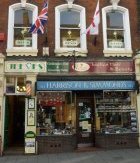Bedford
High Street History
Places > Bedford > Streets > High Street
Harrison and Simmonds - Tobacconist and Fancy Goods
78 and then 80 High Street
Home | Harrison and Simmonds | Sources | Images
Harrison and Simmonds
 There had been a tobacconist shop, Covingtons, at 78 High Street, Bedford,
since at least 1884; but by 1918 the premises had been divided into two shops
(No.78 being the tobacconists and 78a being the Carlton Shoe Company). By 1926
the tobacconist was William Percy Mayo. It was in May 1928 that he sold the
business to Ernest Harrison and his nephew, Nathaniel Harrison Simmonds, both of
whom had moved up from the West Country, and the family firm was established
here. Over 80-odd years later, and five generations, it is still a family firm.
There had been a tobacconist shop, Covingtons, at 78 High Street, Bedford,
since at least 1884; but by 1918 the premises had been divided into two shops
(No.78 being the tobacconists and 78a being the Carlton Shoe Company). By 1926
the tobacconist was William Percy Mayo. It was in May 1928 that he sold the
business to Ernest Harrison and his nephew, Nathaniel Harrison Simmonds, both of
whom had moved up from the West Country, and the family firm was established
here. Over 80-odd years later, and five generations, it is still a family firm.
The shop used to open at 8am and did not close until 8pm, with the door open all day, every day, regardless of weather. Personal service was always the watch-word and a regular clientele was built up over the years, who would come in for their tobacco and cigars and everything to do with smoking: cigarettes, pipes, matches, lighters, cigarette boxes, ashtrays and tankards to hold cigars. Bedford being a popular county town retirement centre for numerous ex-military men and colonial administrators, Major or Captain so-and-so would come in, place their orders (either paying then or having the cost put on their account) and then leave, arranging to have their items delivered to their home, since Gentlemen did not carry parcels. Posh cars would stop outside the shop. One member of the Russell family of Woburn Abbey, Lady Romula Russell, was a regular customer whenever she needed to buy birthday gift cigars for male members of her family. She always wore enormous hats on her visits to the shop.
Shop assistants served and blended tobaccos to suit customers tastes and also weighed out snuff. They would know what regular customers liked, and knew each customers profession, business or trade (and would recommend them to others). Many customers used the shop for decades. Assistants had always to greet customers with a smile and Good morning, sir" (or "Madam", although it was very much a 'mans shop'), always had to look as though they were doing something and never sit down.
The firm began to specialise in producing their own in-house tobacco brands for pipe smokers, such as Majors Mixture or a range which they named after characters in Dickenss novels, such as Oliver Twist and Scrooge.
The family took great pride in the quality of their window displays and changed them frequently. Over the decades they won prizes for their displays of goods.
During the Second World War, regular customers were given priority for under-the-counter items not displayed to the public, to retain loyal patrons, but often they just ran out of tobacco and had to close the shop until new stocks arrived. Families would place orders for absent members of the family, away at war, and the firm would send tobacco products abroad to them. The firm had the opportunity, at this time, to buy the premises and the bank agreed a loan but they decided not to take the risk, given the possibility of the shops destruction by enemy bombers.
Post-war, they extended their range to include Parker pens and Remington electric razors and became local agents for Ronson and Colibri. Nathaniel Simmonds would meet up with other High Street shop managers for coffee each weekday morning at 10.30am at the Cadena cafe, at the entrance to the Arcade.
Before the Second World War, smoking was a fashionable thing to do but from the 1960s onwards, as concerns regarding the ill-effects of smoking on health began to impact on sales, and as the new supermarkets took a lot of the trade from independent tobacconists, the family decided to diversify further. Harrison & Simmonds began selling walking sticks, leather goods, globes, barometers, detailed scale models of cars and aeroplanes. They invested in a computerised engraving machine, since they had always done engraving for presentation items. They began selling goods on the Internet as well as through mail order. The family are committed Roman Catholics, so they began selling religious items such as crucifixes and rosaries.
These days they feel that they are now one of a dying breed of specialist shops where personal service is still given and staff know about what they are selling. In 1971 the lease on No. 78 (with 78a) ran out and the firm moved its shop a few yards up the road to larger, deeper premises at No. 80 High Street and took with them the old-fashioned counter and shop fittings which are still on show at the back of the shop, today. It is well worth a visit to give one a sense of what shops were like earlier in the twentieth century.
Stuart Antrobus 2011
Further Sources
- For more details and anecdotes see: Why Harrison & Simmonds?: 80 Years of a Family Business and What Went Before by Anne Theresa Simmonds , H & S, May 2008. BED/SIM Bedford Local Studies Library
- Harrison & Simmonds
http://www.h-s.co.uk/about_us
Images
Page last updated: 28th January 2014
